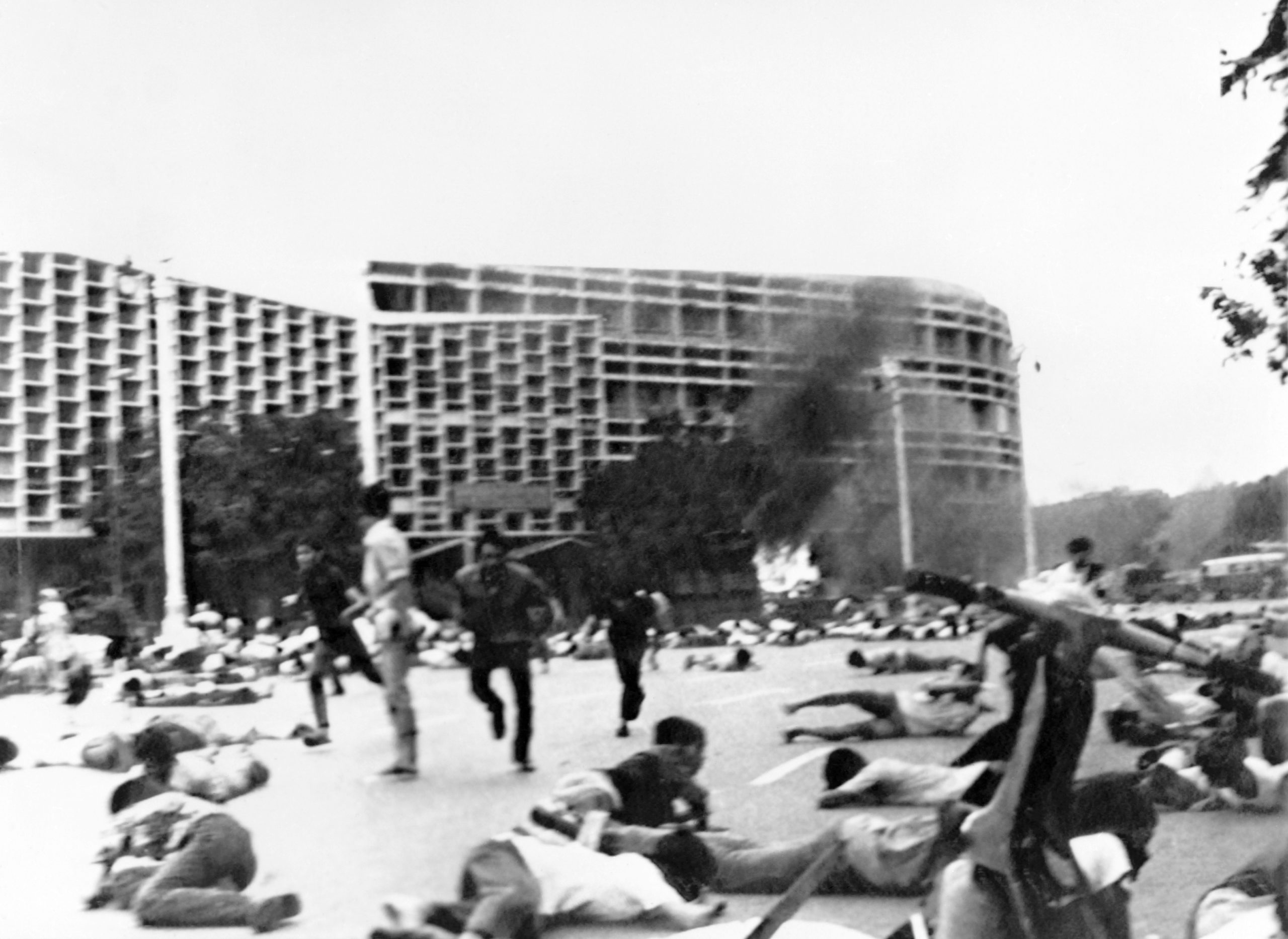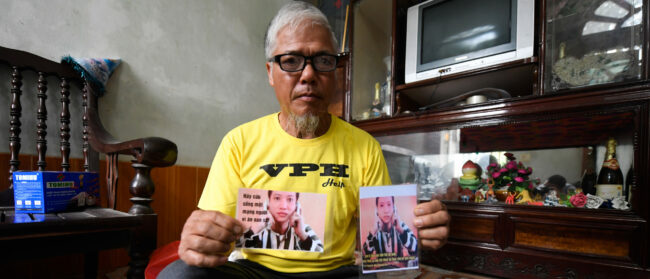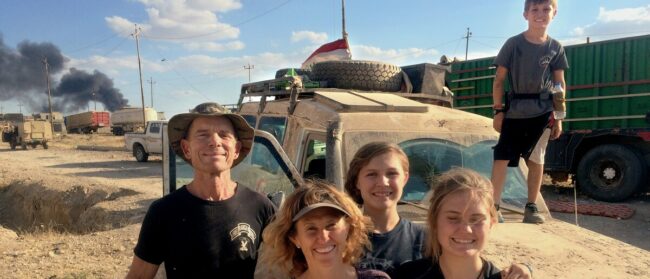Thailand’s military rulers have long had difficulties sharing uncomfortable stories.
The painful anniversary of the massacre at Thammasat University on October 6, 1976 has never been reconciled, buried in a kind of “organised forgetting.” As history books have been censored, appearances cancelled, or activists detained by governments past and present, a new generation of Thais should recognise the massacre for what it truly was – organised hate.
While the scale of destruction pales compared history’s most notorious incidents, such as the Holocaust or the Rwandan Genocide, the hallmarks are similar.
The Rwandan radio station Radio-Television Libre des Mille Collines had incited majority Hutus against the Tutsi minority, describing them as inyenzi, or cockroaches.
During the Second World War, Japanese propagandists referred to their American counterparts as demons, reflected in a 1944 popular magazine that urged all Japanese to “beat and kill these animals that have lost their human nature! That is the great mission that Heaven has given to the Yamato race, for the eternal peace of the world!”
History’s darkest moments are constant reminders of how quickly individuals can become accustomed to condoning brutality or become willing participants in acts of horrific violence. These same chilling characteristics were present in the years and months leading to the events of October 6.
Former Field Marshal Thanom Kittikachorn’s suspicious return to Thailand as a monk sent fears among the students who had ousted him in 1973 soaring. In Nakhon Pathom province, two labour activists, Chumporn Thummai and Wichai Ketsriphongsa, were hanged on September 25, 1976 while protesting Thanom’s return. News of their hanging were memorialised in a skit at Thammasat University, which was mistakenly portrayed as an effigy of then-Crown Prince Vajiralongkorn.
In the space between 1973 and 1976, Thailand had become a fiercely divided place, with a surge in leftist movements enjoying a more democratic space and a deluge of right-wing organisations mobilising to defend Thailand’s ideology of “nation, religion, and monarchy.” Among them were paramilitary organisations such as the Village Scouts (luk sua chaoban), Nawaphon, and the Red Gaurs (krathing daeng), who had been communicating via right-wing media that students were desperate Communists, or something far worse – as something less than human.
On the day before October 6, the right-wing paper Dao Siam reported that the skit about labour activists was an attempt to destroy the monarchy. Students were accused of being either Chinese, Vietnamese, or Communist. Radio station announcers accused the students of committing lese majeste and called for right-wing groups to rally – and possibly attack them for offending the monarchy. Armored Division Radio (Yan Kro) soon began vilifying Communists at Thammasat, while many believed the students had taken a step too far. Some Army radio stations had urged the Village Scouts to come to Bangkok to help fight against “armed Communist-inspired students in Thammasat University.”
Within hours, Red Gaurs and Village Scouts began massing outside Thammasat University, egged on by right-wing radio, urging them to treat unarmed students as inhuman enemies. At that same time, nearly 5,000 people had gathered to peacefully protest the return of Thanom. The combination was lethal.
In the early morning hours, handguns and explosive devices could be heard being lobbed toward the crowd or toward campus buildings. Rocket-propelled grenades were soon fired toward the crowds, injuring dozens. The Border Police also arrived on campus, who along with the military, turned their weapons on the peacefully-protesting students. Many who tried to escape or surrender to authorities were shot. Bodies of students were lynched, tortured, molested – including having their corpses burned or mutilated by a mob of angry counter protesters.
According to government sources, 46 people died during the massacre, with more than 160 wounded and 3,000 people, mostly students, were arrested. Many claim that more than 100 students were killed that morning.
Propaganda had dehumanised and demonised students, labelling them as enemies of the state or or puppets of the Communist Vietnamese.
What preceded the horrific violence at Thammasat on October 6, 1976 was nearly as ghastly. Radio stations, owned or controlled by the military, encouraged the spread of anti-student propaganda. Yan Kro played violent songs such as nak phaendin (heavy on the earth) and rok phaendin (scum of the earth). It suggested that 3,000 students should be killed in the name of national security.
Propaganda had dehumanised and demonised students, labelling them as enemies of the state or or puppets of the Communist Vietnamese.
The internal propaganda had so infected the country that jingoistic tunes were eventually sung by school children. One song in particular described students who criticised the government as being a “burden on the country”, while other forms of propaganda warned local villagers to be fearful of students because many of them were purported to be “communist bloodsuckers” who would forcibly drain the blood of innocents into large bottles for the use by pro-communist guerillas in the North.
Communism prompted the controversial nationalist monk, Kittiwuthō, to wage a kind of holy war against it. Kittiwuthō believed Thailand’s period of democratisation had created a period of general unrest and that it was part of a Communist conspiracy. Therefore, students who had been involved in trying to reorganise Thai society into something other than a regime-directed or led by the monarchy should fervently be opposed.
Kittiwutthō constructed Communists as political opponents, not only as those who could be defeated via a more powerful and antithetical political discourse, but as the very embodiment of “the Evil One”, who had to be physically removed because of its perverse ideology. These “bestial types” would destroy Thailand’s national ideology and were not complete persons.
The events of October 6 are easy to dismiss as distant memories of a turbulent past that aren’t likely to be repeated. Yet, these deplorable qualities of humanity were present in the anti-Thaksin movement as well.

Thaksin was cast in dichotomous terms (good vs. evil), as Yellow Shirt elites invoked rhetoric that he aimed to overthrow the monarchy, casting him as a “savage.” He was also assailed by the late Forest Monk, Luang Ta Maha Bua. Red Shirt protesters were portrayed as inhuman or as animals, being called “red buffaloes” (khwai daeng), which is a derogatory term in Thailand, as water buffaloes are considered by some to be unintelligent animals.
Former Thai Army Chief Gen. Apirat recently referred to student-led protesters in the context of a virus that could not be cured. He also caught attention by asking the media to listen to the same nationalist anthem played before October 6.
To borrow the tired metaphor from Gen. Apirat, it is better to take precautions against a deadly virus like hate, than to allow it additional space to spread. Thailand should remember October 6 for what it was – a menacing, yet preventable act of organised hate.
Mark S. Cogan is an Associate Professor of Peace and Conflict Studies at Kansai Gaidai University in Osaka, Japan. He is a former communications specialist with the United Nations in Southeast Asia, Sub-Saharan Africa, and the Middle East.


